Traveling around Japan by rail is one of the best ways to explore the country. Whether zipping across at 320 kph (200 mph) on the high-speed Shinkansen bullet train, photographing rice fields with Mount Fuji as a backdrop on the Fuji Excursion Limited Express, or squeezing into a packed subway for a jaunt across town, this guide gives you the essentials to make the most of Japan’s rail networks.

I. Riding Local Trains and Subways
The first thing to note is that Japan does not have a single unified local railway system. Instead, multiple operators including JR (Japan Railways), private railways, and municipal subways operate independently, sometimes overlapping. This means you may need to change trains and buy a separate ticket for each segment.
IC Cards
For this reason, locals use IC cards—prepaid, rechargeable cards that let you tap in and out at electronic ticket gates. There are many, but two of particular interest to tourists are Welcome Suica and PASMO Passport. (Note: Don’t confuse Welcome Suica with the regular Suica card for residents. The Welcome Suica is for tourists.)
The Welcome Suica and PASMO Passport can be used on trains, subways, and buses across Japan, even some trolleys and taxis. They don’t require a deposit, are valid for 28 days from first use, and can hold up to 10,000 yen in credit. While non-rechargeable, you can return the card within the 28-day period for a refund for any remaining balance.
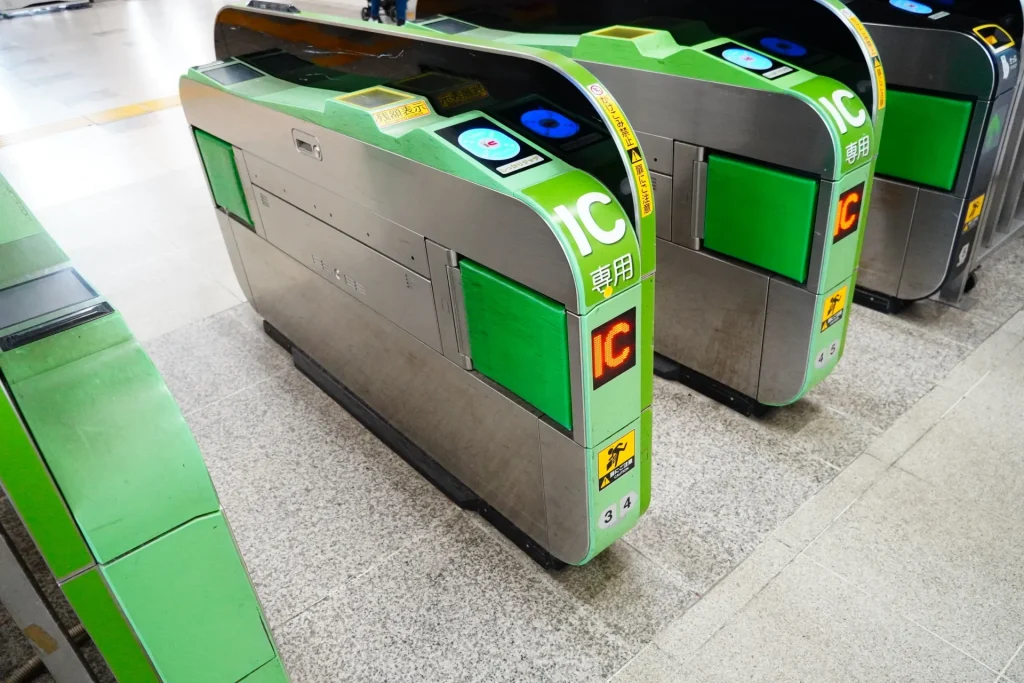
Tip: IC cards are a convenience, not a necessity.
Pros: IC cards eliminate the need for cash. In large cities, they are faster and more convenient than paper tickets, especially for multiple transfers.
Cons: IC cards may not be usable in the countryside or at small rural train stations. IC cards cannot be used on the Shinkansen unless you’ve taken the extra step of linking them to a Shinkansen reservation service, such as JR’s Smart EX website or a compatible app that offers ticketless boarding.
Non-Electronic Tickets (Paper Tickets)
If you don’t want to keep track of a prepaid IC card, or if you need a receipt to log transportation expenses for certain segments, you can buy a one-way ticket from vending machines inside the station.
To determine the fare, simply look up at the rail network diagram above the machines, locate your destination, and pay the amount indicated.

Tip: Take note of the final destination of your train (e.g., bound for Osaka) to know which side of the platform to stand on.
Pros: Paper tickets from vending machines offer machine-generated receipts. Vending machines accept 1,000, 5,000, and 10,000 yen notes.
Cons: Ticket fares are non-refundable; if you decide to get off early or if you lose your ticket, you’ll have to pay the full fare. On the other hand, if you end up going further than the ticket you bought, head to the fare adjustment machine located at the exit to pay the difference.
Types of Local Trains
Regular trains (futsu densha) stop at all stations.
Express trains (kyūkō) stop only at major stations. They are faster because they bypass the smaller stations and serve major points. There is no extra charge for express trains, and they depart from the same tracks as the regular trains, so before entering any train, make sure it stops at your destination.
Limited Express trains (tokkyū) are faster than regular trains, only stop at select stations and usually require a surcharge with reserved seat options.
Etiquette: Speak quietly, set phones to silent, and don’t eat on local trains or subways (drink bottles acceptable).
II. Riding the Shinkansen (Bullet Train)
If you plan to travel between major cities, you’ll likely ride the Shinkansen, Japan’s famous bullet train. Many tourists purchase a Japan Rail Pass (JR Pass), which lets you hop on and off the trains freely during a set period: 7, 14, or 21 consecutive days, depending on the pass you choose.
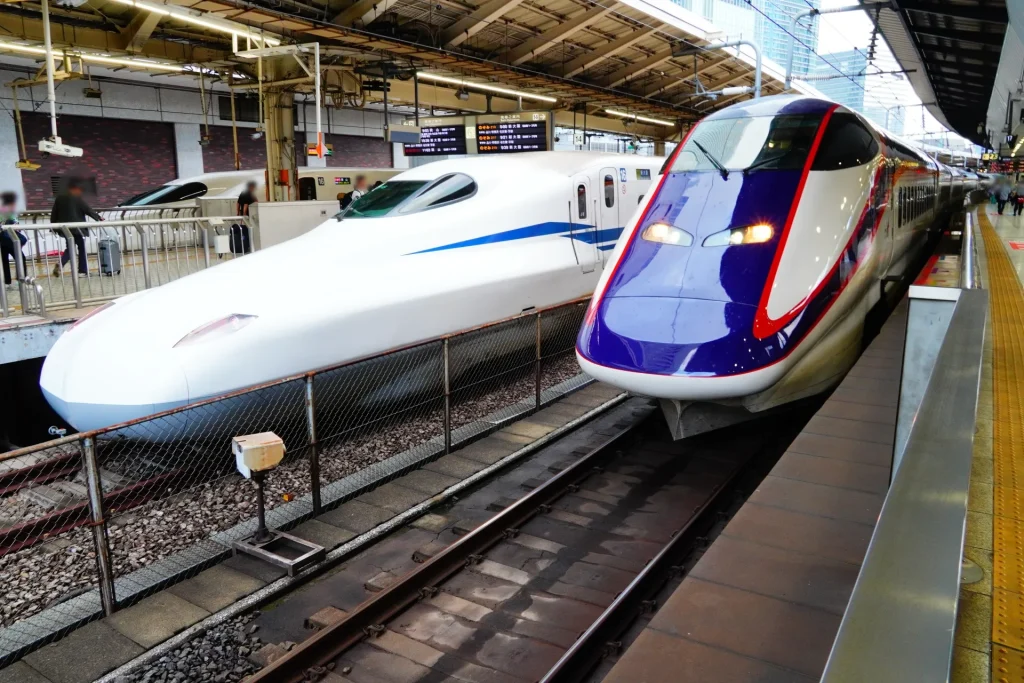
Note: Nozomi and Mizuho trains are not included with the JR Pass.
Shinkansen Tickets (with JR Pass)
If you have a JR Pass, you can board most Shinkansen trains without needing a paper ticket. The pass covers both your base fare and the limited express surcharge. Simply insert your pass into the gate, and it will pop out the other side.
The following high-speed trains are available to JR Pass holders: Hikari (Tokyo-Osaka), Kodama (Tokyo-Hakata), Hayabusa (Tokyo-Shin-Hakodate-Hokuto), Sakura (Shin-Osaka-Kagoshima), Tsubame (Hakata-Kagoshima-Chūō), Hayate (Tokyo-Shin-Hakodate-Hokuto), and Komachi (Tokyo-Akita).
Nozomi and Mizuho trains are not covered by the JR Rail Pass but can be accessed by purchasing a supplementary, reservation-only ticket, available at the JR Travel Service Center ticket counter (Midori no Madoguchi).
Tip: The JR Pass can also be used on local JR trains and busses, and a few underground subways but not private lines or private subways (ex: Tokyo Metro, or Osaka Metro). The pass also works on the sole JR ferry, a ten-minute ride that plies between the outskirts of Hiroshima City and Miyajima Island.
Shinkansen Tickets (without JR Pass)
If your travel is minimal, you may prefer to buy Shinkansen tickets individually, as you go.
Basic Fare Ticket (jōsha-ken) – This covers the distance traveled. It’s the same fare to ride an ordinary non-express JR train over that distance. The jōshaken is always required, whether you’re on the local yokel or the bullet train (but not the subway).
Super Express Ticket (tokkyū-ken) – For Limited Express Shinkansen, the term “Super Express” indicates superior comfort and speed. A tokkyū surcharge is necessary; without it, you’re not authorized to ride the Shinkansen.
Reserved vs. Non-Reserved Seating
Reserved seats (shite-seki) guarantee a seat and are recommended. Reserved tickets are marked with car and seat numbers, along with departure and arrival times.
If you have oversized luggage, some Shinkansen trains have a reservation-only baggage space behind the last row of seats in certain carriages, which you may request at the time you purchase a reserved ticket. When using your reserved space, luggage with wheels should be laid on its side.
Green Cars offer premium, first-class seats and require a special (more expensive) reserved ticket. A Green Car Rail Pass is also available.
Note: Not all Shinkansen trains have Green Cars.
Tip: Reserved seats are free for JR Pass holders and can be made up to one month in advance. During peak seasons, to avoid overcrowding, some trains may offer only reserved seating. It’s advisable to book early during busy seasons.
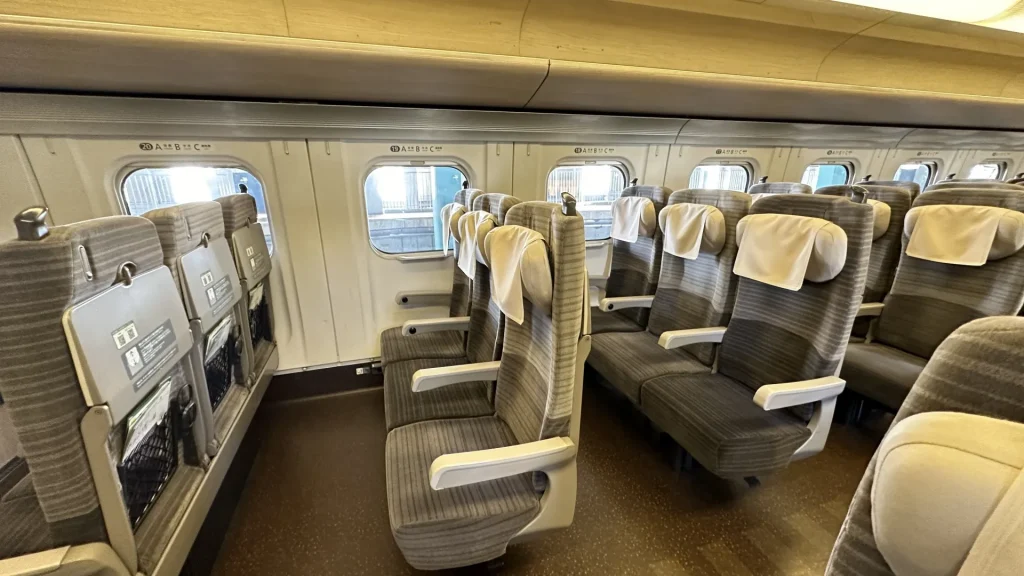
Non-reserved seats (jiyu-seki) are first-come, first-served and usually located in cars 1-3. Non-reserved tickets are valid for 1 day.
With a non-reserved ticket, you can board the non-reserved car of any train headed to your destination that offers non-reserved seating; you are not tied down to a particular departure time.
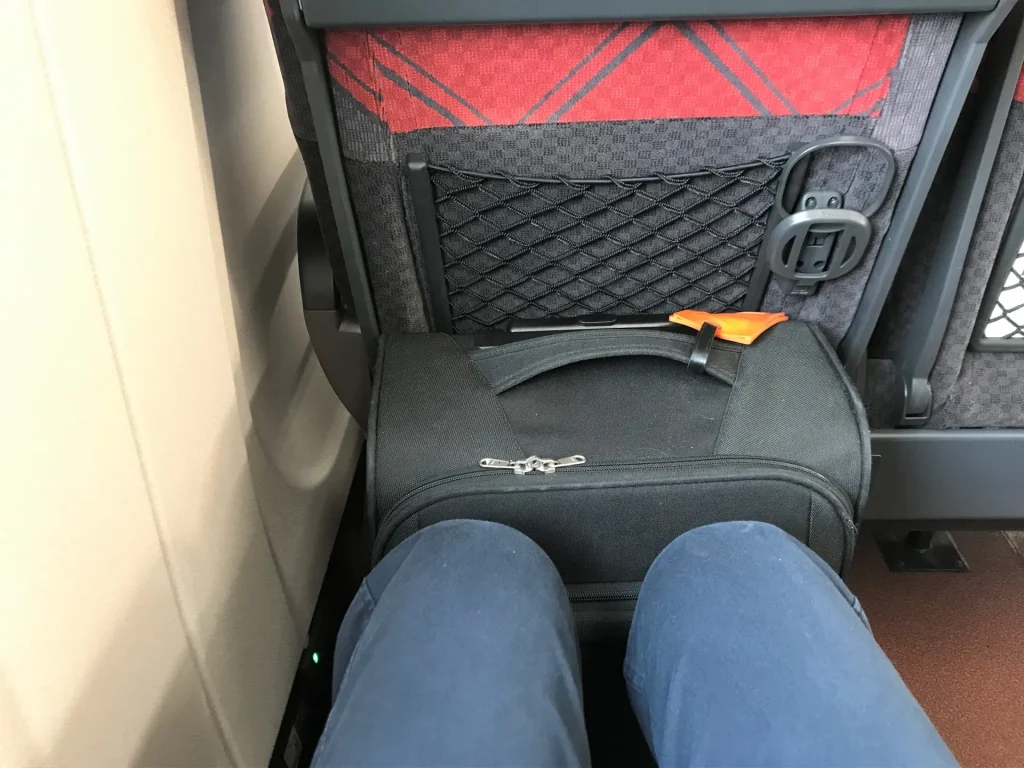
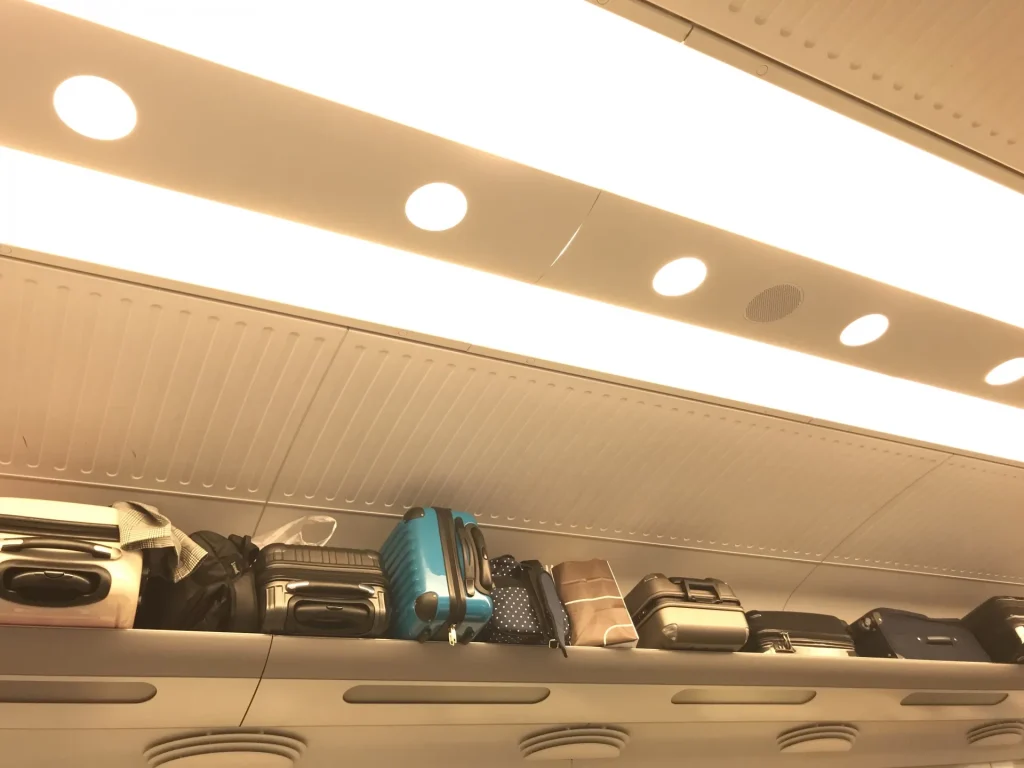
When in a non-reserved seat, place your luggage on the top the rack above your seat (optimal), in front of your knees, or in the aisle next to your seat, making sure it doesn’t impede passengers moving through the aisle. Keep hold of your suitcase, as the high-speed Shinkansen vibrates and your suitcase will likely roll down the aisle without you!
Note: Oversized baggage spaces cannot be reserved by those with non-reserved seats.
During busy times, you may not get a seat in a non-reserved car, meaning you’ll have to stand between the cars or in the aisles.
Etiquette: If you can’t get a seat, do not sit on the floor, as this is considered uncouth in Japan.
You may be tempted to sit in an obviously empty seat in one of the reserved cars. Do not sit there unless you plan to pay for it when the conductor checks tickets. Trying to “game the system” does not impress the Japanese.
***
Your JR Rail Pass is, by default, a non-reserved ticket. You can get a reserved seat by booking in advance. There are two methods available:
Reserved Seat Ticket Vending Machines
Major JR stations are equipped with Reserved Seat Ticket Machines that support JR Pass holders by using the QR code printed on the pass. You can also make seat reservations at the JR Travel Service Center ticket counter. Be sure to have your JR Pass and your passport with you for both.

Note: Seat reservations can be made up to one month in advance. There is no extra charge for JR Pass holders. A reserved ticket will show the car name, number, row, and seat designation.
How to Buy Shinkansen Tickets
Train station vending machines with multiple language support are available, but may be complicated for those unfamiliar with Japan’s system.
For easier navigation, consider purchasing tickets online through the JR website.
Online fares purchased through the JR website will have a QR code which you can exchange for a paper pass at the JR Travel Service Center ticket counter. In this case, all the details—jōshaken (basic fare), tokkyūken (limited express surcharge), and seat reservation—are typically printed on a single travel slip. When you insert it into the electronic gate, it will be scanned, stamped, and returned to you on the other side.
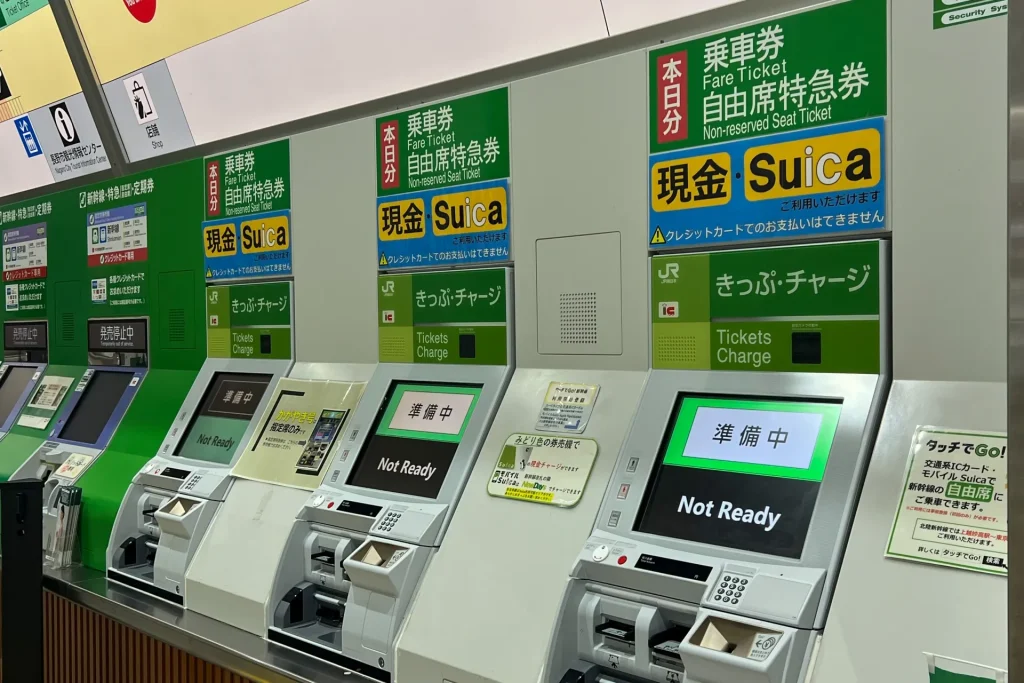
Tip: Always leave ample time to catch your train.
To the Platform
The ticket gates for local trains and the Shinkansen are separate, so use the correct entry point with the appropriate passes. Sometimes the Shinkansen gates are inside the regular train gates, in which case your Shinkansen tickets will work in both gates. If you’re entering with multiple paper tickets, you must stack all of them—usually two or three—and insert them into the gate together. The machine will process them, keeping your jōshaken (base fare), and return the others, which will pop out as you walk through. Don’t forget to take the remaining tickets with you. If you leave them behind, the machine will flash a warning, delaying the people behind you.
When boarding with a pre-linked IC card, tap the card at the gate and the gate will print a small boarding slip with proof of reservation and, if applicable, seat information.
How to use multiple tickets for Shinkansen or express trains
Example:
1 Fare ticket + 1 Reserved Seat ticket, traveling from Kyoto to Hiroshima
Tickets you Will Receive
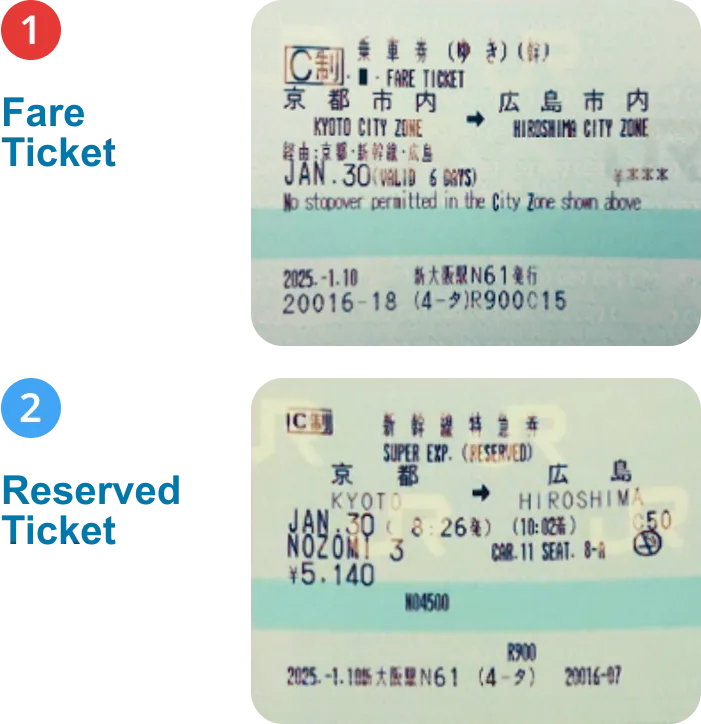
Travel Route from Kyoto to Hiroshima
This shows the section you will travel with the tickets above.

How To Use the Ticket Gates
1. At Departure Station (Kyoto)
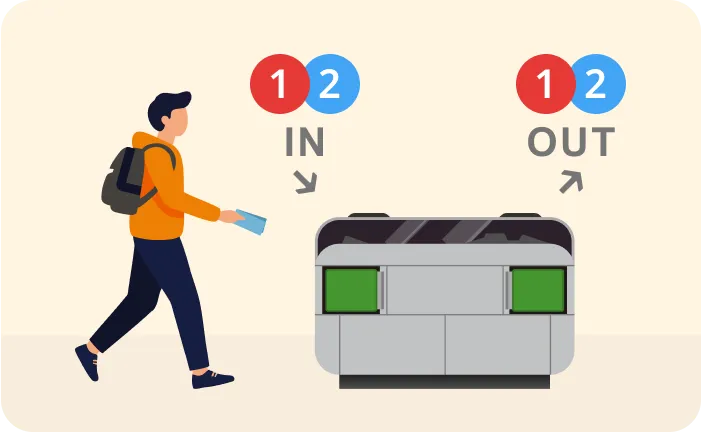
Take them both back once you have walked through the gate to the other side.
2. Second Gate (if needed)
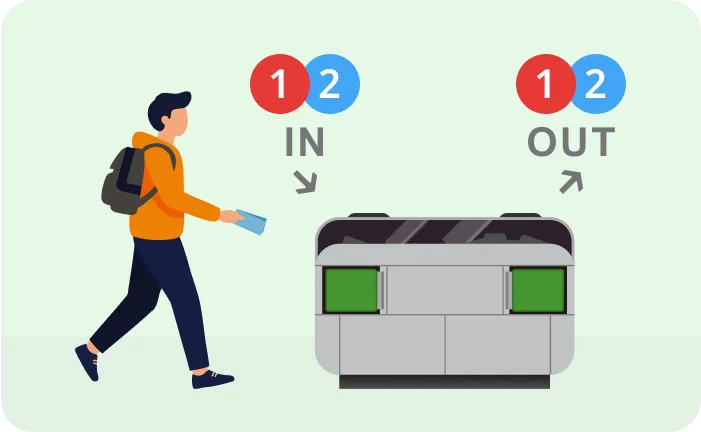
3. At Arrival Station (Hiroshima)
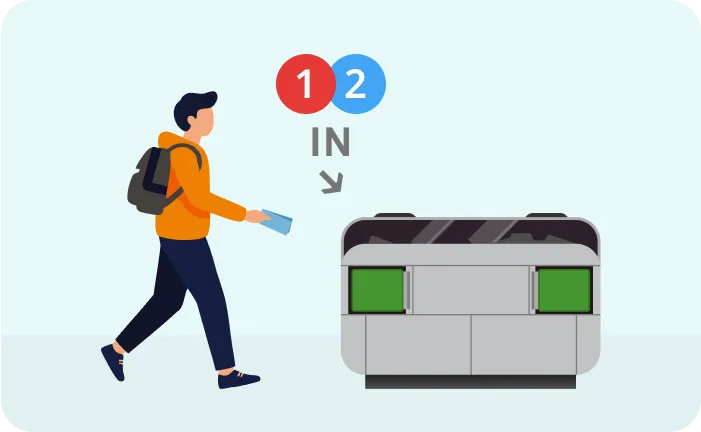
Example:
1 Fare ticket + 2 Reserved Seat tickets
Travel Route from Odawara to Takayama, via Nagoya
Tickets you Will Receive
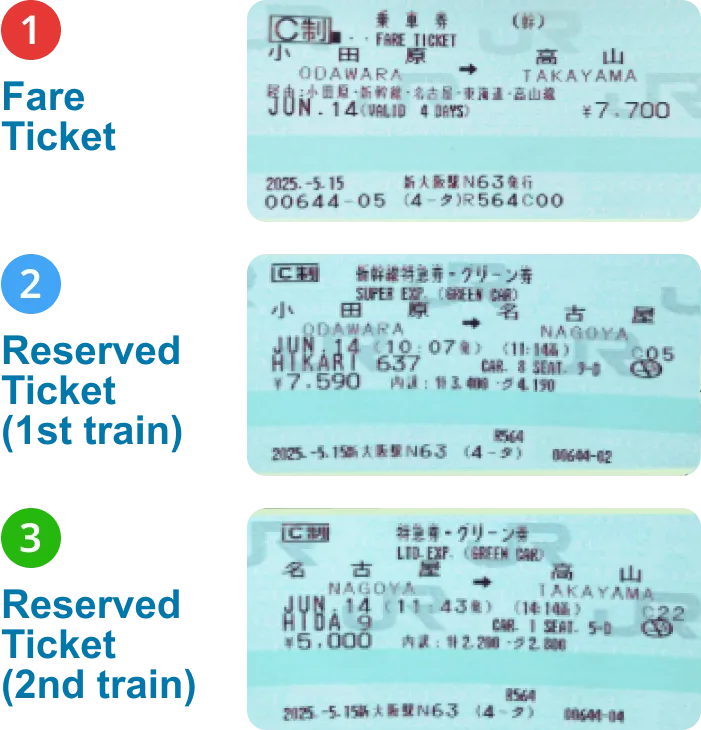
Travel Route from Odawara to Takayama, via Nagoya
This shows the section you will travel with the tickets above.
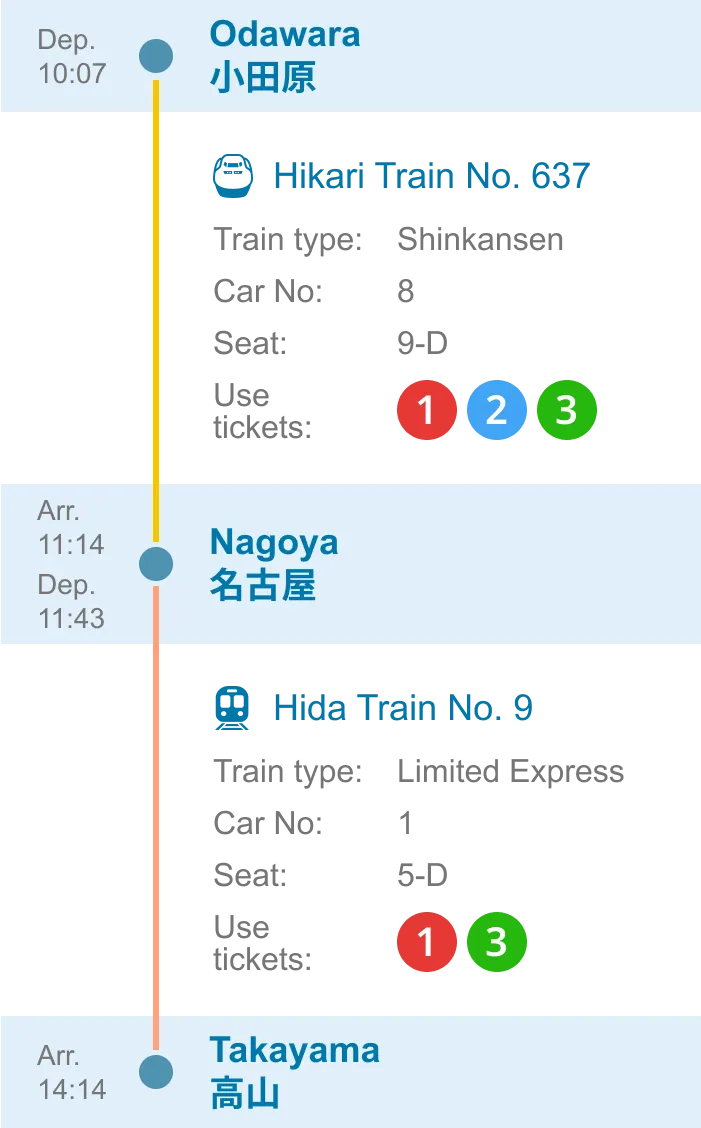
How To Use the Ticket Gates
1. At Departure Station (Odawara)
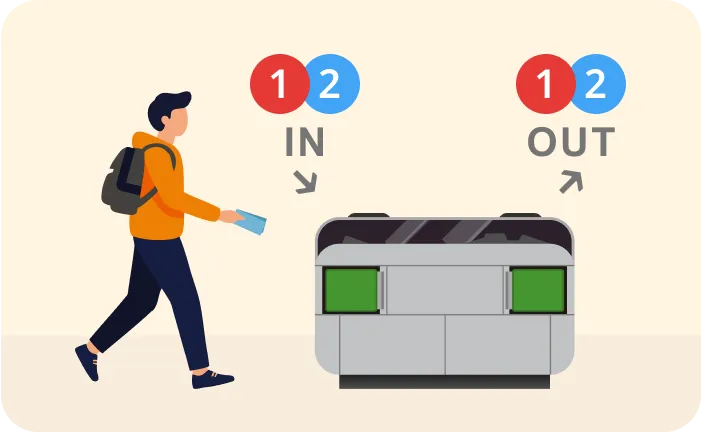
2. At Transfer Station (Nagoya)
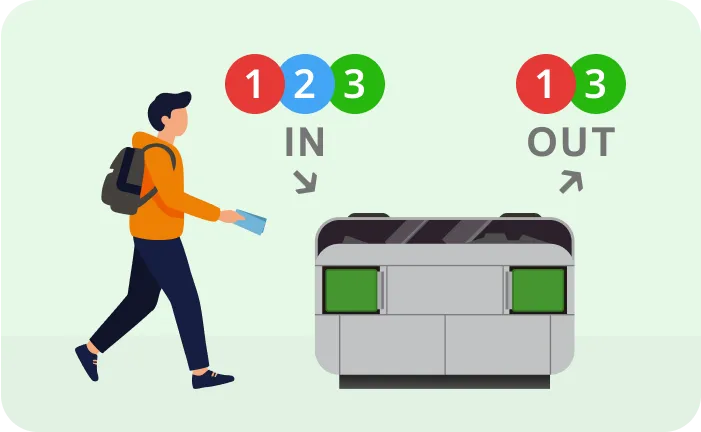
3. At Arrival Station (Takayama)
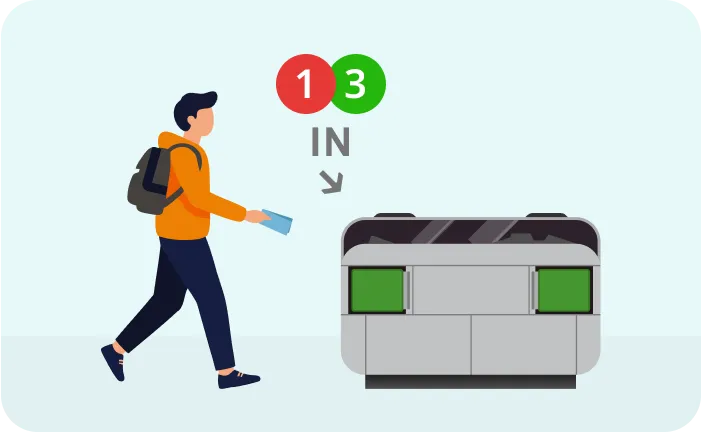
Caution
You must keep your tickets with you from departure until arrival.
Do not forget to take your tickets when you pass through the ticket gate.
Some Fare tickets are valid for local JR trains within the city of your arrival. At some stations (e.g. Hiroshima), ticket ① may come back when inserted into the gate. Please keep it to continue using JR trains within the valid area.
Finding Your Platform
Once you’ve gone through the turnstile, look up at the electronic signboard to see the list of trains and track/platform numbers. This is a good time to become familiar with the name and number of your train, such as Hikari No. 532 or Sakura No. 10. Double-check that the train name, number, and departing time match your ticket.
Since Japan’s high-speed rail system spans more than 2,800 kilometers (1,740 miles) of track from Hokkaido to Kagoshima, much of it runs on elevated tracks passing over cities, roads, rivers, and countryside. As a result, platforms are typically on the second level of the train station, reached by stairs, escalators, or elevators.
Tip: At the bottom of each stairway or escalator, you’ll find a diagram showing which car numbers stop closest to that particular staircase. If you note your carriage number in advance, you can head straight to the right spot—saving you from hauling your luggage down long, narrow platforms through crowds of people embarking, disembarking, and lining up for the next train.
Etiquette: When you need to stop to regroup or double-check information, look for a pillar to stand next to so you’re not blocking others trying to move forward. This is true for stopping in any narrow, crowded space in Japan, but especially in train stations.
At the Platform
Japanese train station platforms are clearly marked. That doesn’t mean, however, that you’ll actually understand them!
First, look at the digital board above to see which track your train will arrive at. Next, note the color-coded markings on the floor along the track that tell you the train name and car number. There may also be a diagram of each train name, labelled with carriage numbers, next to the track. Once you have located your car number, line up in the designated position where the train doors will open. Once the train arrives, wait for passengers to alight before boarding.“
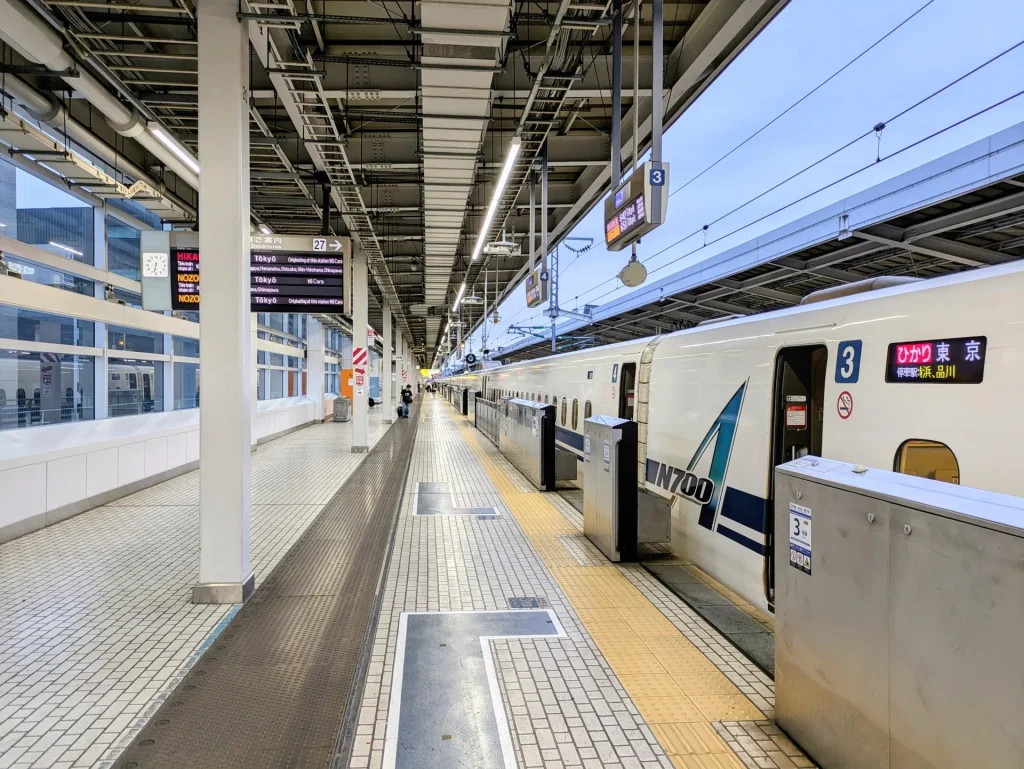
Note: Trains may only stop for 30-60 seconds, just long enough to let people step on or off. Be ready!
Tip: The most important information about your train is the name, number and destination (ex: Hikari 532 to Osaka), not the departure time. This is especially important when asking station attendants or others for help.
Etiquette: Once on the train, speak quietly (whispering is de rigueur), and set phones to silent mode. Keep your luggage close if it’s not in a luggage rack or reserved luggage area Now that you’re onboard, kick back and let your high speed adventure begin!

